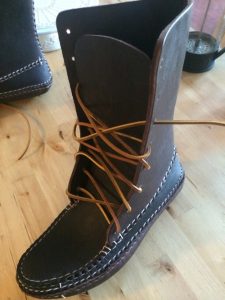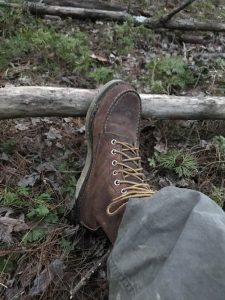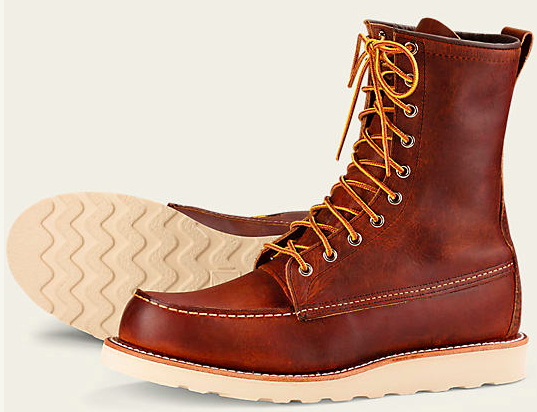When it comes to footwear, I have a somewhat unique experience. Growing up in Kentucky as a boy, basketball was the local obsession and, like many other young men, I have the scars to prove it. Double knee surgery, a second single knee surgery, torn ankle ligaments, a broken finger and broken nose are just a few of the major injuries and pains I’ve suffered from too much basketball played on too many courts and streets of my youth.
Of all the injuries I’ve suffered, however, the torn ankle ligaments have been by far the most long-lasting in their impact on my day-to-day life. Because my ligaments no longer hold the bones in my feet in place, I have a tendency to suffer dislocated bones. Imagine how it feels when a vertebrae in your back is out, but amplified and localized in your foot—with the entire weight of your body pressing down on the dislocation. Add in the periodic collapsed arch and I found myself spending as much as three months a year on crutches or barely hobbling around.
After visits to podiatrists, $500 orthopedic inserts, a myriad of different shoes, I finally came to a realization—my feet didn’t hurt when I was walking around the house barefoot. I asked my podiatrist why and was told it was an “unexplained phenomenon we sometimes hear about, but don’t know why it happens.” Needless to say, that was my last visit to the podiatrist.
 Instead, I went home and ordered some moccasins—yes, real leather moccasins. Specifically, I ordered the Bush Boot from Arrow Moc, easily one of the highest quality moccasins on the market. Over the next couple of years, my feet steadily improved, the pain diminished and collapsed arches largely became a thing of the past. Unfortunately, however, leather moccasins leave a lot to be desired in some circumstances. No matter how much you waterproof the bottoms, there is only so much rainy weather you can walk in before your feet are soaked. Even worse is the experiencing of walking in a public restroom only to walk right back out because there is simply too much urine on the floor to safely get anywhere near the toilet in soft, leather-soled footwear. Because of these disadvantages, I had occasionally tried different boots over the years to see if there was any that would work with my feet.
Instead, I went home and ordered some moccasins—yes, real leather moccasins. Specifically, I ordered the Bush Boot from Arrow Moc, easily one of the highest quality moccasins on the market. Over the next couple of years, my feet steadily improved, the pain diminished and collapsed arches largely became a thing of the past. Unfortunately, however, leather moccasins leave a lot to be desired in some circumstances. No matter how much you waterproof the bottoms, there is only so much rainy weather you can walk in before your feet are soaked. Even worse is the experiencing of walking in a public restroom only to walk right back out because there is simply too much urine on the floor to safely get anywhere near the toilet in soft, leather-soled footwear. Because of these disadvantages, I had occasionally tried different boots over the years to see if there was any that would work with my feet.
The Red Wings 8830: Why I Tried Them
This search ultimately led me to Red Wing’s Heritage line of boots, specifically the 8830 model. For those unfamiliar with the 8830, it is identical to the famous model 877, with the only difference being the slightly darker leather used, rather than the orange-hued leather the 877 sports. There are several factors that led me to give this iconic line of footwear a shot:
- Leather footbed. Unlike many modern shoe/boot designs, Red Wing’s Heritage line has no fancy insoles or arch supports built into the boot. Instead, the insole is a simple piece of leather running from toe to heel. This allows the footbed to mold and conform to your foot very much like a pair of leather moccasins.
- Non-lined uppers. Like the footbed, the entire upper portion of the boot is just leather, with no lining, insulation or waterproof inner shell. Like the footbed, this allows the upper portion of the boot to conform to the shape of your foot and ankles as well.
- Single piece, rubber crepe sole. Because the 877 was originally designed for outdoorsman and farm workers, the rubber crepe sole is known for being comfortable and quiet, two qualities important to me as an avid hiker and backpacker. In addition, although I don’t have any proof of this, I strongly suspect that the sole being one piece more evenly and gently transfers the shock of walking, as opposed to a boot with a differentiated heel. With a differentiated heel, it only takes a few steps before I start feeling that old, familiar pain—something that has not happened with Red Wing’s crepe sole.
- Goodyear Welt Construction. While the crepe sole has definite advantages, longevity is not one of them. Fortunately, thanks to the Goodyear welt construction, it’s a simple matter for Red Wing to completely replace the sole, extending the boot’s life without the need to break in a new pair. It’s not uncommon for Red Wing owners to have a single pair of boots for years, or even decades.
The Red Wing 8830: Quality, Sizing, Break-In and Wear
One of the first things you notice about these boots is the attention to quality. Being from the Heritage line, the 8830s (and their 877 siblings) are made in America, using oil-tanned leather from Red Wings own tannery. The process gives the leather a full, rich look that ages beautifully with a nice patina. The leather is also thick enough that, with proper care, it should last for many years.
The major seams are triple-stitched, using nearly century-old Puritan sewing machines that melt wax into the stitching. This helps make the seams water resistant.
When researching Red Wing boots, I was somewhat puzzled by other people’s obsession with Red Wing’s laces. After a month of wearing these boots, I’m beginning to see why people like them so much. I have yet to have the laces come undone or untied even once.
The sole is exactly what I expected, based on all the research I did before buying. The sole is very soft, shock absorbent and quiet. Given how much time I spend in the woods, I was concerned with how loud more traditional boots would be over the moccasins I’ve been wearing. Ultimately, however, this has been another area where I’ve very impressed with the 8830s. Walking in the woods, off-trail or on, these boots are very quiet.
Red Wing recommends going half a size smaller than you normally wear, and I found this to be true in my case. I normally wear a 9, but a 9 left too much room at the end of my toes. Going with an 8.5 made it a little harder to initially put the boot on, but left just the right amount of space in the toe-box. For someone looking to buy a pair, I would definitely recommend starting half a size small. Even if the boots feel tight at first, the leather will conform to the wearer’s foot.
Red Wings are notorious for their brutal break-in period. Depending on the individual, both pair of boots and person, break-in can range from a couple of weeks to a couple of months. For someone with my foot problems, a horrendous break-in period is not really a luxury I can afford. If the break-in period is too rough, I could find myself with dislocated bones and collapsed arches. Fortunately, in my case at least, the break-in period wasn’t all that bad. Because the boots start out tight, I wore them with dress socks the first couple of days. This made it easier to slip my feet in and out. The next couple of days I graduated to standard, white athletic socks I’ve had for the better part of a year and have worn a bit thin. Finally, I graduated to thicker SmartWool and brand-new athletic socks. All-in-all, the break-in was only uncomfortable for a few days, and never severe enough to cause any major problems. In fact, after a few weeks, the boots now conform to my feet almost perfectly.
The Red Wing 8830s: Where I’ve Worn Them
 In the couple of months of owning these boots, I’ve worn them almost every day in a variety of circumstances. I’ve worn them around the house, running errands, to social engagements and in the woods. That’s part of the beauty of Red Wing’s Heritage line, and the 877 family in particular—they’re as rough and capable as the day they were introduced in 1953, yet look good enough to be used for social activities or even business casual.
In the couple of months of owning these boots, I’ve worn them almost every day in a variety of circumstances. I’ve worn them around the house, running errands, to social engagements and in the woods. That’s part of the beauty of Red Wing’s Heritage line, and the 877 family in particular—they’re as rough and capable as the day they were introduced in 1953, yet look good enough to be used for social activities or even business casual.
In particular, when I was researching these boots before purchase, I was interested in how they perform in the woods. Unfortunately, it was hard finding any comprehensive reviews or information in that context. To put them to the test, I went on two backpacking trips in the Red River Gorge of Kentucky. The Gorge is a well-known destination among rock climbers, bouldering enthusiasts, backpackers, hikers and general outdoors people. The Gorge’s terrain varies from rocky cliffs and outcroppings to valleys with gentle, creekside trails.
For both backpacking trips, I went to one of the more remote regions of the Gorge, starting off in a valley and ascending to the high ridges where the trail proceeded to take me to rock cliffs and outcroppings. These trails gave me the ability to test the boots in a variety of terrain, soils and underfoot debris. I was especially curious how much traction the boots would provide given their relatively shallow traction crepe sole. In each type of terrain, I was very impressed, with the boots providing a sure-footed grip. Walking up and down trails, even muddy ones, was no problem. When walking around cliff outcroppings, the boots were practically glued to the sandstone rock. In fact, the only time I remember slipping was on a slight incline that was slick, Kentucky clay—the kind of clay that is notorious to locals for gumming up almost anything and providing zero traction.
Conclusion
Having worn the 8830s for nearly a month, including on two rigorous backpacking trips, what’s the verdict? Are they a worthy substitute for old-fashioned leather moccasins?
The short answer: Yes. Red Wings are the first boots or shoes in years that I’ve been able to wear without ending up in excruciating pain and resorting to crutches or a cane to get around.
While nothing can quite compare to the lightweight, flexibility of moccasins, or the nearly barefoot ground feel they provide, the Red Wings are extremely comfortable, and offer a level of protection and durability that moccasins can’t match (the fact that I can use any public restroom, regardless of the condition of the floor is an added bonus).
While Red Wings are expensive—at approximately $290 a pair—the fact they can be resoled multiple times over makes the $290 a small price to pay, especially when a pair of Arrow Moc Bush Boots runs over $200 as well. While Arrow Moc offers resoling, leather moccasins require it much more often than a crepe rubber sole.
Would I recommend Red Wings? Without hesitation! For people without the ligament damage I’ve suffered, these boots are some of the finest on the market. For someone coming from a minimalist perspective, these boots are the next best thing to old-fashioned leather moccasins in the realm of ordinary boots. There’s a reason Red Wing calls these “Classic Mocs.”
Pros
- High quality leather uppers that will last for years
- Goodyear welt construction that allows indefinite resoling
- Leather footbed conforms to your foot
- Extremely comfortable when broken in
Cons
- Rubber crepe sole wears quickly
- Break-in can take a few weeks
Rating
4.5 out of 5
